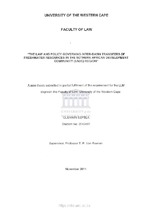| dc.contributor.advisor | Van Reenen, Tobias | |
| dc.contributor.author | Sefela, Glenwin | |
| dc.date.accessioned | 2019-04-02T13:03:04Z | |
| dc.date.available | 2019-04-02T13:03:04Z | |
| dc.date.issued | 2011 | |
| dc.identifier.uri | http://hdl.handle.net/11394/6619 | |
| dc.description | Magister Legum - LLM | en_US |
| dc.description.abstract | Water scarcity is a worldwide threat. Fresh water resources are vital to human existence
and survival. The challenge faced relates to the way these water resources are being
distributed and managed. As an answer to this challenge, humans responded with what is
commonly known as water transfers. A water transfer refers to the importation of water
where water supply is low. Water transfers are, however, not a new concept as it dates back
to the ancient Mesopotamians. Today, due to the global population having drastically
increased, water transfers, or inter-basin transfers (IBTs) are increasingly being used as a
means to minimize current water shortages. | en_US |
| dc.language.iso | en | en_US |
| dc.publisher | University of the Western Cape | en_US |
| dc.subject | Environmental law | en_US |
| dc.subject | Integrated river basin management | en_US |
| dc.subject | Integrated water resource management | en_US |
| dc.subject | SADC- Southern Africa Development Community | en_US |
| dc.subject | Policy | en_US |
| dc.subject | Governance | en_US |
| dc.title | The law and policy governing inter-basin transfers of freshwater resources in the Southern African Development Community (SADC) region | en_US |
| dc.rights.holder | University of the Western Cape | en_US |

